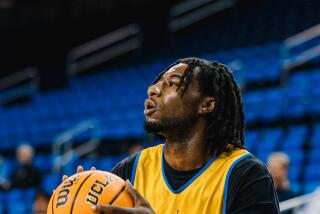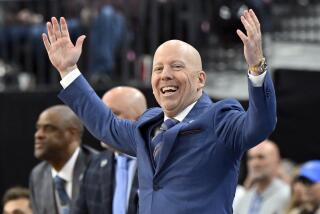Just Not the Same
The first ones came Monday night, staked out their territory in the shadow of Pauley Pavilion, set up tents and began a two-day vigil, their numbers expected to grow as the hours go by. These UCLA students operate in teams, one always manning their post if the other must leave for class, bring back food or perhaps get away to jog.
And to what great cause are these students so dedicated? What lofty goal drives them?
Victory on the basketball court within the four walls behind them. These students are waiting for seats for tonightâs game between their beloved Bruins and the Trojans in the annual visit of the USC menâs team to Westwood.
The students already have tickets, but they are in line for one of the 488 priority passes for prime seats, being handed out today on a first-come, first-served basis.
âItâs only because we hate SC so much,â Matt Crisafulli said in explaining why heâs willing to give up a few days of his life.
The fierceness and passion surrounding the annual UCLA-USC football game is well-known around the nation. But the feelings are not so widespread for basketball. Competition is the lifeblood of any rivalry. During the years the Bruins were dominating college basketball, beginning in the mid-1960s, the Trojans paled in comparison.
That made it all the sweeter for Bob Boyd, who coached USC from 1967 to 1979. Starting with the 1963-64 season, the season in which the Bruins won their first of 11 NCAA titles, UCLA beat USC 17 straight times, lost two in a row, and then won 19 in row. Those two Trojan victories were with Boyd as coach.
âThey were so overwhelmingly favored with the likes of Lew Alcindor and [Bill] Walton,â said Boyd, retired and living in Palm Desert, âthat it was important to us.... We were outmanned, most people felt, and probably, from the coachesâ standpoint, never given the credit by the media, because they werenât too pleased with the way we played the game. In those days, we wanted to keep our offense on the field and there was no clock. We had the ball for long periods of time because we couldnât stop Alcindor. It was pretty exciting to win.â
The excitement comes easily to players who grow up in the area and compete against each other at many levels.
It was different for Larry Farmer, who wound up in the middle of the rivalry as a Bruin player, assistant coach and then coach.
âI grew up in Colorado,â Farmer, a TV analyst, said from his Wisconsin home. âI didnât know I was supposed to hate SC. I would watch the Rose Bowl game as a kid, and SC was usually in it. I became kind of a fan. But when I got to UCLA, I learned about the rivalry. I learned you are not supposed to like them. We had to keep up our honor since they were trouncing us pretty good in football.
âThe students who wrote for the two school newspapers would switch places and write all this garbage about the other school and that would also naturally get everybody up.â
In comparing those days with today, Boyd doesnât think the rivalry has maintained its intensity.
âIt seems like some of the glitter of the UCLA mystique, and particularly Pauley Pavilion, isnât what it was during my time,â Boyd said. âIt was quite big-time.â
What appealed to Farmer was a schedule that had the schools playing each other on back-to-back nights.
âIt would be Friday at our place and Saturday at their place, or vice versa,â Farmer said. âThat weekend was a happening.â
The rivalry will have a fresh start this year with Tim Floyd, in his first year as USC head coach, coming to Pauley to face Ben Howland, now in his third season with the Bruins.
âI think itâs certainly special for fans who have lived and worked alongside UCLA people,â Floyd said. âItâs important to coaches because they recognize that itâs important to fans. I think thatâs the extent of that. Thereâs just no way in the world you can put forth any more effort than weâve put in for Arizona or Arizona State or Washington State in terms of preparation.â
Howland sees it in terms of a bigger picture.
âRival programs like USC and UCLA,â Howland said, âcompete in everything: swimming and diving, soccer and volleyball, baseball. Itâs important to both schools and the alumns and the students. And itâs great for the city.â
Trojan guard Lodrick Stewart, who comes from Seattle, admitted he didnât get it at first.
âItâs kind of growing on me now,â said Stewart, a junior. âIt wasnât all that big of a deal when I first got here, but everybody makes it such a big deal, so I have to take the game more seriously. Itâs like your own trophy if you win against them, to be the best team in town.â
Bruin guard Jordan Farmar says he need look no farther than the tents in front of Pauley Pavilion to inspire him.
âBecause they want the best seat in the house,â Farmar said, âthese students are willing to sleep out here. I feel that passion carries over to the court.â
*
(BEGIN TEXT OF INFOBOX)
Hoop scoop
Facts on the USC-UCLA series:
Overall: UCLA leads, 121-98.
* Longest UCLA streak: 19 (1970-79).
* Longest USC streak: 42 (1932-43).
* Current: UCLA has won two in a row.
* Biggest UCLA win: 37 points (UCLA 99, at USC 62; March 5, 1967).
* Biggest USC win: 34 points (USC 60, at UCLA 26; Feb. 9, 1941).
*
SERIES BY DECADE
*--* * 1928-30 USC 6-3 * 1931-40 USC 33-4 * 1941-50 USC 23-17 * 1951-60 UCLA 23-11 * 1961-70 UCLA 23-6 * 1971-80 UCLA 19-1 * 1981-90 UCLA 13-7 * 1991-2000 UCLA 14-6 * 2001-current Tied 5-5
*--*
More to Read
Go beyond the scoreboard
Get the latest on L.A.'s teams in the daily Sports Report newsletter.
You may occasionally receive promotional content from the Los Angeles Times.







